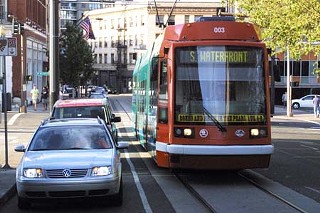Streetcars: Fast facts
Fri., July 20, 2007
• Streetcar systems run on fixed steel rails. Most often laid directly in the street, rails also can run in a dedicated median or beside the street.
• Streetcars usually operate in mixed traffic and share a traffic lane with vehicles; they can share sidewalk stops with buses.
• Streetcars are powered by electricity. Typically overhead electrification is provided by a catenary or string wire.
• Streetcars are slow – they run at speeds of 3 to 10 mph. This makes them pedestrian-friendly and lends a traffic-calming effect.
• Most new U.S. streetcar lines start up with about five cars in service; the streetcars run about every 10 to 15 minutes.
• Starter streetcar systems typically average 2 to 3 miles to serve a defined loop, area, or streetcar district. Most cities with new systems in place are planning expansions.
• Fares charged nationally range from a free ride to one-way fares in the $1 to $1.50 range. (Cap Metro's model is a free streetcar, to promote ridership.) Fares cover at most 25% to 30% of operating costs.
Got something to say on the subject? Send a letter to the editor.







